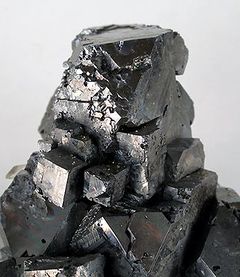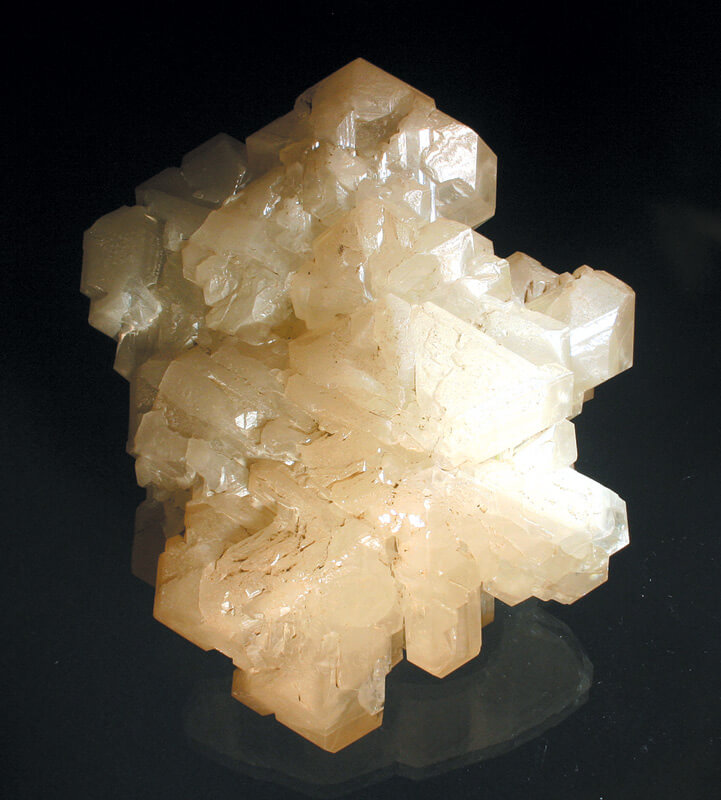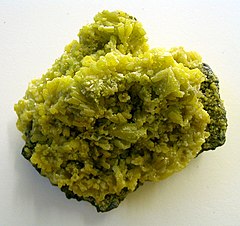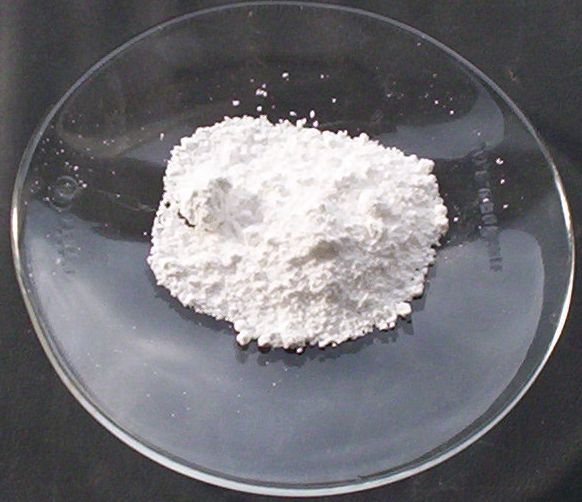Table of Contents
Lead compounds part of the Lead Mineral Group, if heated with carbonate of soda on charcoal before the blowpipe flame, yield malleable metal, and also a yellow oxide of lead incrustation. If dissolved in nitric acid, the white sulphate of lead may be thrown down as a precipitate by adding sulphuric acid ; or as chloride of lead by adding hydrochloric acid. As, however, other chlorides might be formed at the same time, the precipitate should have ammonia added to it, when, if chloride of lead, it is unaltered.
Galena (the principal ore of lead)
- Crystallization—cubical and cleavable in cubes, also octahedral.
- Lustre—shining metallic ; the surface may be dull, but the fracture is brilliant.
- Colour—lead grey.

- Streak—lead grey.
- H.— 2·5; S.G.— 7·5.
- Composition—when pure, 86.6 per cent, lead, the rest sulphur.
Unless heated carefully in the B.F. it is apt to decrepitate, but eventually yields a globule of lead. Can be decomposed by nitric acid. Galena can be distinguished from silver and other ores by blowpipe and Chemical tests as well as by its characteristic cubical cleavage. The ore usually contains a perceptible amount of silver, and its presence may be observed by dissolving the ore in nitric acid and dipping a piece of bright copper into the solution, when a silver film will be formed. A galena ore should always be carefully assayed for silver, as sometimes it is very rich. It is an erroneous notion that fine-grained galena is more argentiferous than a coarse-grained one, though it might be in a particular district. Galena is frequently found in gold bearing lodes.
Carbonate of Lead (white lead ore)
- Often found near surface of a galena lode.

- Compact, earthy, or fibrous masses.
- Crystallization—prismatic.
- Structure—brittle.
- Lustre— glassy or adamantine; is transparent or translucent, when pure.
- Colour—white or greyish (sometimes with a bluish tinge) and often discoloured brown.
- Streak—colourless.
- H.—3 to 3·5; S.G.—6·5.
- Composition—75 per cent, of lead, the rest carbonic acid.
- Before B.F. a lead bead is obtained.
If dissolved in nitric acid, and a piece of clean zinc be dipped in the solution, brilliant lead laminae will be precipitated on the zinc. Effervesces in acids. Red oxide is sometimes found on surface of lead ores, notably at Leadville, Colorado, on the carbonates. Specimens of a carbonate should always be examined for fragments of chloride of silver or chlorobromide of silver.
Pyromorphite
- Colour—greenish, sometimes bright grass green, the hexagonal crystals having a greasy lustre, also yellowish, brownish, and sometimes dull violet.
- Streak—whitish or yellowish.
- Lustre—more or less resinous; generally translucent.
- H.—3·5 to 4; S.G.—6·5 to 7.
Contains 78 per cent, of lead, as well as phosphorus, &c. Heated on charcoal before the B.F., a globule is formed which crystallizes on cooling, while a yellow oxide of lead incrustation is seen on the charcoal. With carbonate of soda in R.F. yields a lead bead. Is soluble in nitric acid.
Chromate of Lead
Is a yellowish mineral containing protoxide of lead and chromic acid. It blackens before the blowpipe and leaves shining globules of lead in the slag. Produces a yellow solution in nitric acid.
Sulphate of Lead
A white, grey, greenish, or bluish, translucent or opaque mineral, with an adamantine lustre. Contains protoxide of lead and sulphuric acid. Rather like carbonate of lead, but is softer and does not effervesce in an acid.
Galena (generally mixed with other metals) is the usual and most productive ore of lead, and is very frequently extremely rich in silver. It is found in rock formations of various ages in lodes, pockets, flats.
The carboniferous or mountain limestones of England yield most of the lead ore, while it is also worked in the “ killas ” of Cornwall, a Devonian formation.
It also occurs in Great Britain and other countries in the Lower Silurian rocks, in granites, gneiss.
The carbonate of lead deposits of Leadville, Colorado, best known for being richly argentiferous, occur between blue limestone and porphyry (Fig. 41).
Galena is generally associated with quartz, carbonate of lime spar, fluor-spar, sometimes barytes, copper and iron pyrites.
If powdered galena be heated in an iron spoon, lead can be obtained. The heat should be gradually raised at first till the pieces cease to decrepitate. After this a red heat will suffice.
The following is a simple method of obtaining lead bullion (though not the proper amount) from an ore, and may be of use to the prospector. Erect a square furnace of rough stones. Place rough logs of wood at the bottom, above this split wood, then broken-up ore, and then wood. The fire should be lighted at the entrance, and the lead allowed to run out into a basin.
